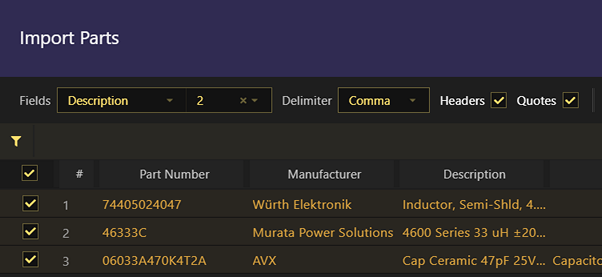Import & Export
Workspaces and pretty much all the tables in the app can be exported and/or imported.
Workspaces
To export or import workspaces, look for the corresponding buttons on the top right corner of the app.

Exporting a workspace results in a .bomist_dump file that you then can import into another workspace if needed. Importing a workspace into another doesn't delete any data on the destination. Instead, it just incrementally adds up data.
Exporting a workspace is also a way of backing it up, and that's exactly what the app does whenever creating backups.
Tables
Export
All tables in the app can be exported into CSV, JSON, PDF and HTML by right-clicking on it and selecting Export.... When exporting tables, its current configuration is respected (i.e. only the visible columns and rows will be exported and in the same column order, sorting, grouping, etc.) so you might want to adjust it to fit your needs.
You might also want to create table views specifically for exporting data and for different situations, so you can quickly switch between your default views and the ones that are used only when exporting data. For example, you might have a table view to list only the parts that are low on stock, including only just a few columns (i.e. visible) so they you'd fit into a PDF page.
When exporting a table into PDF, because you are limited by the paper's size, you might need to limit not only the columns that should be visible but also their sizes so they'll fit in the page.
Data can be exported into PDF in portrait or landscape mode, so each display mode will naturally limit the number of columns you can display on the PDF.
Import
Importing data into tables is normally done through CSV files (the exception here are storage locations, as storage locations have a tree-like structure). Depending on the data you are importing, the app expects some fields to be passed which you can then map to the columns in your CSV file.

When loading a CSV with headers that match the fields the app expects, the headers get automatically mapped. For example, if the app expects a Part Number to be passed and there's an header with that exact name in the CSV file, then it gets automatically mapped.
CSV files can be drag-and-dropped into tables in order for the app to import its data and on the corresponding table (currently, only importing purchase orders doesn't support this).
Tree-structured data
In some cases the data to be imported has a tree-like hierarchical structure (e.g. Storage and Labels). Since this sort of structure cannot be easily represented on a CSV file, text files (.TXT) are used instead, with tabs defining the depth of the nodes in the tree.
An example:
Shelf
A
A1
A2
B
Room
A
B
Note that to the left of "A" there's a single tab while to the left of "A2" there's two tabs. If you don't need hierarchical structure you can simply have all the names in single column (no tabs), just as you would on a CSV file.
When importing data you'll be prompted with a merge confirmation dialog highlighting the new nodes, so you can review the changes resulting from importing data into existing one.
API
Another way you have to import or export data is by using the REST API which is served by the app (not on the cloud). You can export the whole workspace (into a .bomist_dump file) through the API if needed or simply fetch and process the specific data you need.